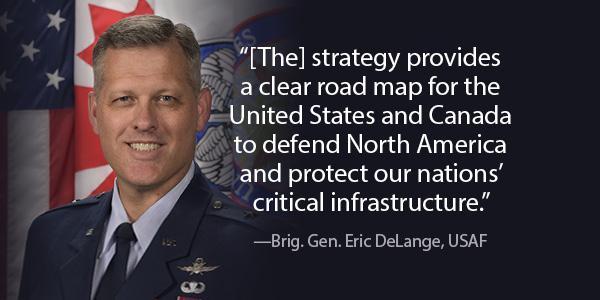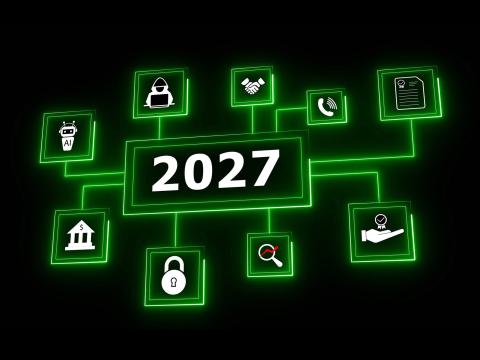European Crises Weighs on Defense Commands Amid Continued Tech Innovation
The United States’ military homeland defense commands, the North American Aerospace Defense Command and the U.S. Northern Command, are facing more complex adversarial threats and current geopolitical strife, all while trying to modernize its technological capabilities to operate more effectively.
The two commands’ top cyber, data and communications leader, Brig. Gen. Eric DeLange, USAF, who is known as the J-6, is working to meet the advanced technology needs, but strives to only employ solutions that will work without failure given the urgent 24/7 operational needs.
The general offered his North American Aerospace Defense, or NORAD, and U.S. Northern Command, or NORTHCOM, perspectives yesterday at the AFCEA Rocky Mountain Chapter’s annual Cyberspace Symposium held in Colorado Springs February 21-24. The commands are led by Gen. Glen VanHerck, USAF.
“Gen. VanHerck’s strategy provides a clear road map for the United States and Canada to defend North America and protect our nations' critical infrastructure,” said Gen. DeLange. “Homeland defense is absolutely the number one priority for my boss.”
The J-6 added that the leaders at the commands work closely with other countries in the region to strengthen protections and partnerships. “Mexico is a partner that we work with quite a lot and the Bahamas, in the Northern Command role, and of course Canada, with NORAD,” he explained.
And although the organizations are two separate commands, they are “very intertwined.” NORAD and NORTHCOM also depend a lot on the capabilities that come from the U.S. Strategic Command and the country’s newest combatant command, the U.S. Space Command, (SPACECOM) to be able to have situational awareness, aerospace warning and aerospace control to defend the homeland.
As part of his strategy, Gen. Van Herck established four strategic priorities: domain awareness, information dominance, decision superiority and global integration, of which the J-6 is supporting the implementation. “Domain awareness is about increasing that warning time, that warning space,” Brig. Gen. DeLange stated. “Again, moving left from the conflict to be able to increase the decision space for senior leaders. Information dominance is about connecting, that sensing that we get from domain awareness and the process allowing senior leaders to have those discussions that can lead to decision superiority.”
And given the present global situation with Russia invading Ukraine, having the two commands be globally integrated is a necessity, he said.
“I don't think in today's environment, and we can even look at what's happening geopolitically in Europe right now, that it is not just a regional activity,” Gen. DeLange noted. “It is having a global impact. It impacts all of our all combatant commands. And so, it is important that we have the tools and the means and have the situational awareness so that leaders can have that shared awareness to make those decisions and move forward.”
As such, NORAD and NORTHCOM are pursuing modernized tools, including virtualization platforms, data analytics, mobile communications and other solutions. “We've virtualized our environment and we're updating the physical infrastructure,” he shared. “We have connectors down to the desktop that they don’t make anymore, so we're [updating] those. We have a Pathfinder capability where we're looking at taking advantage of the data that's already in the radar systems that has been out there but not simulated into the systems of record that now we are interested in.”
The commands’ communications solution for classified is a welcomed mobile capability. “COVID certainly prompted a lot of that [need for mobility], but being able to have any of our users that need both unclassified and classified access wherever they might be, has been a huge boon for the command, to again be able to increase that decision cycle wherever you need to collaborate to get after information.”
Meanwhile, the North Star effort is providing important dashboard capabilities and situational awareness in real time. “In our daily [meetings], instead of the commander getting a brief in PowerPoint that talks to the last 24 hours, it is, ‘This is what's happening now,’ and ‘Let’s have a discussion on what it is now, real time,’ and ‘What are we doing about it for the future and how are we going to posture and position ourselves?’” the NORAD/NORTHCOM J-6 said.
Command and control capabilities remain a priority, as does resiliency. The commands look at its cyber operations components from a mission assurance perspective. “We partner with U.S. Cyber Command to use some of the Cyber Protection Team (CPT) capabilities in a direct support role, but also at our own headquarters from a SOC [security operations center] perspective and what we're doing for cyber security, and resiliency,” Gen. DeLange stated.
Their cyber activity also includes Canada, he added.
“Canada is building out its capabilities too, and what does it mean to have a U.S. CPT on Canadian NORAD mission space and vice versa,” he shared. “We are working through some of those authorities and processes.”
All of the cyber protections and improved tools do aid the commands’ role. “Gen. VanHerck very much wants to move the discussion and the argument left into the competition and crisis phases where we can increase the decision space for our senior leaders, so that ideally we never get to the conflict,” Gen. DeLange stated. “If we have the situational awareness and we have the understanding and we can bring all instruments of power of the whole of government to bear, maybe we can preclude conflicts to begin with.”





Comments